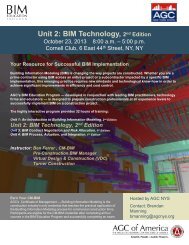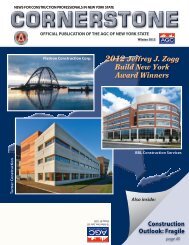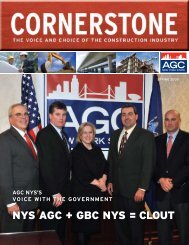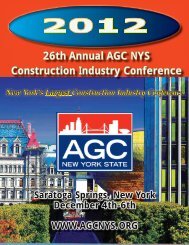CORNERSTONE - The Associated General Contractors of New York ...
CORNERSTONE - The Associated General Contractors of New York ...
CORNERSTONE - The Associated General Contractors of New York ...
You also want an ePaper? Increase the reach of your titles
YUMPU automatically turns print PDFs into web optimized ePapers that Google loves.
18<br />
Several years ago, I was called in<br />
to facilitate partnering on a public<br />
school project in the Southern<br />
Tier. Actually, I was called by the<br />
school’s architect and attorney to discuss<br />
liquidated damages they were<br />
contemplating (justifiably so) a very<br />
large daily LD on a medium sized project<br />
with multiple primes that was to be<br />
completed over the summer. Having<br />
convinced them to engage in Partnering<br />
as a better means <strong>of</strong> completing the<br />
project on time, we began with a workshop.<br />
In the course <strong>of</strong> the workshop, it<br />
became clear that that issue <strong>of</strong> payment<br />
would be one <strong>of</strong> the keys to success <strong>of</strong><br />
the project. <strong>The</strong> owner was convinced<br />
<strong>of</strong> the value <strong>of</strong> allowing requisitions<br />
Payment on Construction in<br />
By: Joe Hogan, VP Building Services<br />
every two weeks. When the contractors<br />
asked how soon they could expect<br />
payment upon submitting the requisition,<br />
the owner immediately responded<br />
with a question <strong>of</strong> his own. “How soon<br />
will you pay your subs after the District<br />
pays you?” was the query to which the<br />
contractors (almost in chorus) responded,<br />
“How quickly would you like us to<br />
pay them?” <strong>The</strong> resulting plan was to<br />
pay the primes in seven days with the<br />
proviso that the primes would pay their<br />
subs within 48 hours after that. This<br />
was an owner and a team that understood<br />
the value <strong>of</strong> cash flow as the life<br />
blood <strong>of</strong> a project. While this was not<br />
the only reason for a great success <strong>of</strong><br />
this project, it was certainly a major<br />
factor.<br />
<strong>The</strong>re are few issues <strong>of</strong> greater importance<br />
on a construction project than<br />
those related to payment. In <strong>New</strong> <strong>York</strong><br />
State, there are rules/laws<br />
that must be considered<br />
for both public and private<br />
work. Moreover,<br />
there are basic rules <strong>of</strong><br />
industry practice, equity<br />
and good sense that must<br />
be applied.<br />
<strong>The</strong> Laws - Public Work<br />
Section 106b <strong>of</strong> <strong>General</strong><br />
Municipal Work<br />
sets forth the payment<br />
requirements for Local<br />
Governments/Municipal<br />
Corporations and School<br />
Districts for both Building<br />
and Civil/Highway<br />
work. <strong>The</strong>se owners are<br />
required to pay the contractors,<br />
within 30 days<br />
<strong>of</strong> the requisition, the<br />
approved amount less<br />
retainage. (Note: In rare<br />
cases such as with Towns,<br />
45 days is allowed) <strong>The</strong><br />
30 day clock starts with<br />
the formal, non pencil<br />
copy, submission to<br />
the owner or his designated agent. If,<br />
therefore, the contract calls for payment<br />
requisitions to be submitted to<br />
the Architect or Construction Manager/<br />
Agent, that is when the 30 day clock<br />
starts ticking - not when that entity<br />
submits the requisition to the owner.<br />
If the payment is not made within that<br />
timeframe, interest is due and owing to<br />
the contractor for each day the payment<br />
is late. While rare, some enlightened<br />
owners automatically pay that interest.<br />
For most, however, you have to make<br />
claim for it. Section 139f <strong>of</strong> State Finance<br />
Law governs most State agencies,<br />
public benefit corporations and<br />
public authorities. It is nearly identical<br />
to the provisions <strong>of</strong> Section 106b with<br />
one key exception – the 30 day clock<br />
does not start ticking until the payment<br />
requisition is delivered to the owner.<br />
For both sets <strong>of</strong> law, no more than 5%<br />
retainage may be held on each progress<br />
payment excepting that when performance<br />
and payment bonds are not required<br />
(Section 137 <strong>of</strong> State Finance<br />
Law demands at least payment bonds<br />
for projects over $200,000), 10% retainage<br />
may be held. Upon substantial<br />
completion, the law states that the<br />
owner is to promptly pay the remaining<br />
contract amount less two times the<br />
punch list and an amount necessary to<br />
satisfy any outstanding claims, liens or<br />
judgements. While the law does not<br />
call for further retainage to be held,<br />
there are some (including a judge 26<br />
years ago) that believe retainage to be<br />
a punch list item and, therefore, it can<br />
be held beyond substantial completion<br />
or even final completion. I view that<br />
argument as a bit silly. Not only does it<br />
fail to understand what retainage is for,<br />
it sets up a circular argument the theoretically<br />
creates a situation where the<br />
project is never truly complete. Punch<br />
list items are to be released as they are<br />
completed. Once they are all completed,<br />
final completion occurs.







